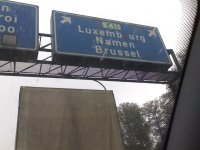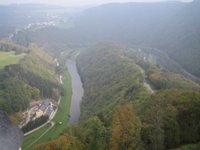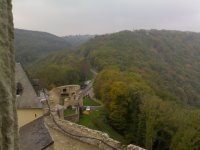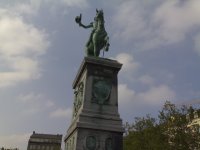
We runaway to
Luxembourg, drove through Esch Sur Sure, stayed in
Bourscheid and ended in
Luxembourg Ville.
The Grand Duchy of
Luxembourg was actually ruled by the
House of Orange-Nassau up to 1890, the year
William III died. Since females were not allowed to succeed in Luxemburg because of the
Salic law, the Grand Duchy passed to the
House of Nassau-Weilburg, a collateral line; this was in accordance with the Nassau Family Treaty of 1783.
Means, this tiny country was historically part of the Netherlands. In my readings, Luxembourg was included in the newly formed United Kingdom of the Netherlands, along with Belgium, in 1814. It fragmented 16 years later, when Belgium broke off from the Netherlands, taking half of Luxembourg along the tug.


1. The Netherlands flag(left) 2. Luxembourg flag (right)
Just a subtle diffrerence huh!
UUUmmm...let's check if we will see traces of Dutch-'ness' there :-).
So, what's in there? Known to be the most expensive country which possesses the highest GDP per capita in the world (US$72,945 as of 2005), then let's see.

We had a long time driving going to
Ecsh Sur Sure where we drove in the northern region of the country. This tiny village is in the west of the region of criss-crossed rocky loop in the
Sure River (Sauer in German) with hiking trails and dotted with picturesque villages and is off the Wiltz-Ettelbruck road. Curved out of the mountainside mostly gently rolling uplands with broad, shallow valleys; uplands to slightly mountainous in the north; steep slope down to other small plains in the southeast. This was our first destination. However, out of good familiarity of the road, we had passed the stopping point and we we're estimately 20 kms away. So, we decided to directly drive tru our second destination, to our hotel in Bourscheid.

We arrived in
Hotel Du Moulin, a modern family-run hotel with privately owned fly-fishery. New indoor swimming-pool available, sauna, solarium and fitness-room.
Hotel Du Moulin in our background.

Only 2 km from the medieval castle of Bourscheid. The next day, we went to the castle and walked around.
Right photo is view from the castle down the hotel.
A 1,000 years old castle situated on the rocky bluff overlooking farmland and the Sure River. The castle's romantic ruins loom 500 feet above the River Sûre, commanding many valleys. The central portion is the castle's oldest sector; surrounding it is a 14th-century wall dotted with circular towers.
The remaining tower of the castle.
This is not as complete as the castle in Vianden ( as many said) but is ultimately more attractive due to its outstanding location. It offers wonderful walking paths in the surrounding woods.

The beautiful hotel is in a magnificent setting with splendid views over the Chateau of Bourscheid. We had a relaxed time staying there with ample of fresh air surrounded by plateaus.

Nestling behind the barrier of the towering Ardennes mountains, the country is protected from the cold North sea winds that gives a temperate type of climate.
Side view from the castle.
The cold was just pleasant enough to have a good walk but windy enough not to stay long at the peak of the valleys like in the castle.
 On the right is an old church in the Bourscheid village. Can you see the flag beside it? (Not in the Philippines..).
On the right is an old church in the Bourscheid village. Can you see the flag beside it? (Not in the Philippines..).The village is also a jumping-off point for hikers wishing to explore the area with fascinating landscape of curious sandstone rock formations, waterfalls, creeks, springs and forests.

Situated on the bank of the River Sûre, in a romantic wood land setting, the hôtel is like a haven of peace. Alter a day's hike in the surrounding forests, you can relax on its riverside terrace or unwind in health & beauty centre of the hotel.
River Sure, good for fishing and hungry campers :-)

Then, we had a long day in the capital city of Luxemburg. Since this little country is, however, located at the crossroads of several major highways, the Grand Duchy is dwarfed between its neighbours France, Germany and Belgium.
Me at the boulevard overlooking the Grund.
It's easy to overlook it when travelling. Our day steps in the city was long, wide and more...more.
At the Petrusee promenade. Does he looks tired? :-)
The entire country is only 51 miles (85km) long and 32 miles (52km) wide, Luxembourg was once called the Gibraltar of the North, and by exploring these fortifications beneath the city, you begin to see why. Most of the immense citadel was destroyed as a prerequisite for Luxembourgois independence in 1815. But what's remaining is still certainly formidable and romantic to explore. ( tugged along with your dovey :-))

With underlying tensions, regardless of the size of the country, it has a distinct local language. Surrounded by other big countries, languages of French, and German live together harmoniously with the Letzebuergesch, the national tongue.
Do I look lost ( or loose) in the jungle? Hehehe.
Uuuumh... I was completely lost here. No one speaks my ever Visayan dialect. I seldom hear English either. Thanks that I understand Dutch as I heard them (tourists) complaining :-) Hehehe! Anyways, some speaks Dutch especially the hotel receptionist or cashier. Why? Belgium is just in the border that speaks Flemish, a form of Dutch. And to think, that Dutch tourists are just anywhere. Prachtig! (Wonderful! ).
The Cathedral of Notre Dame.
As we walked through the city, I don't hesitate to stop awhile and probe behind the glass office blocks and official buildings to find a land of fascinating medieval fortresses, rolling woodlands, sun-drenched castles, and quaint villages. Ja, I observed that buildings around are crafted with modern-glassy architecture mixing with old textural styles. In the city, you can see a lot of banks. Almost every second building in the city is a bank, that dubbed Luxembourg as a banking central of Europe.

We walked through the old cobble stone paths along the boulevard Roosevelt to Plateau Du St. Esprit where superb panoramas of the valleys and over the Grund. We walked down to the Montee du Grund (Ground) known also as Old Towns'Bock which is an ancestral lower village and rock galleries. Housed the Casemates down-under the Grund and was a bomb shelter of thousand locals during WWI and WWII.
Right is at the Old Town close to the Scott's pub.

We had drinks at the Scott's Pub located at the border of the river Petrusse and has a lovely terrace at the waterfront.
British Scott's Pub.
It is calm and tranquil country with no hurry, no stressing crowds of people (except the Place d'Armes and tourists) just a nice stuff for your eyes and silence. The street and aura is medieval.

There at the square of Place d'Armes, the old town's pedestrianized core stands the
equestrian monument of William III of Netherlands ( Grand Duc Guillaume in French).
We even passed and walked in by the Musee National d'Histoire et d'Art. A multilevel state-of-the-art glass atrium showcasing Roman and Middle Ages artifacts collection.

In the middle of town, with no warning, we suddenly found ourselves in front of the palace of the Archduke of Luxembourg. Almost like a 'normal' grand house, only bigger.
The Palais Grand-Ducal is about more than 400 years old.
The soldier keeping watch is the solely and patiently marching back in forth in front of the gate. (Now, I remembered the dedicated officer standing beside Jose Rizal's monument, Philippine national hero, that even to slaap a fly atop of his nose is forbidden). The building was started in 1572 but it has been added on, redecorated and even restored after an explosion during the time that it served as a town hall in the 17th century. The palace is just within the heart of the center..and you may just right at its gate and bump the guard while you are shopping.
My dear standing in front of the palace. It is not busy during Sunday.
We also try to beat the busy-shopping streets but for any reason...
I can't find anything which I like. It was Sunday, and just any other European country, most shops are closed on sundays. Well it's ok...I don't like my bodyguard to wait long for me outside the store. Hehehe! I married a shopping-allergic person...prefers to sit and read newspaper or walk all the way-round rather than scrutinizing shops and customizing items. Hmmmh...

Luxembourg is not even big enough on most maps of Europe to contain the letters of its name just like Netherlands, but makes up in snazz what it lacks in size.
Photo was shot from the Petrusse valley. A garden overlooking from the Place de la Constitution.
As Netherlands have abundance of canals, windmills and proud of its flatness, then Luxmbourg is the pride of the hinterlands. It has a wealth of verdant landscapes mounted in by winding valleys with fast-flowing rivers and dotted with the sort of rural hamlets that most people associate with fairy tales.
Our stay was associated with ancient memories. And for that...the place is worth another chance to re-visit. We will be there again for the next holiday....in a sporty-trailing mood backpacking :-) A bientôt dans Luxembourg!



 We had a long time driving going to Ecsh Sur Sure where we drove in the northern region of the country. This tiny village is in the west of the region of criss-crossed rocky loop in the Sure River (Sauer in German) with hiking trails and dotted with picturesque villages and is off the Wiltz-Ettelbruck road. Curved out of the mountainside mostly gently rolling uplands with broad, shallow valleys; uplands to slightly mountainous in the north; steep slope down to other small plains in the southeast. This was our first destination. However, out of good familiarity of the road, we had passed the stopping point and we we're estimately 20 kms away. So, we decided to directly drive tru our second destination, to our hotel in Bourscheid.
We had a long time driving going to Ecsh Sur Sure where we drove in the northern region of the country. This tiny village is in the west of the region of criss-crossed rocky loop in the Sure River (Sauer in German) with hiking trails and dotted with picturesque villages and is off the Wiltz-Ettelbruck road. Curved out of the mountainside mostly gently rolling uplands with broad, shallow valleys; uplands to slightly mountainous in the north; steep slope down to other small plains in the southeast. This was our first destination. However, out of good familiarity of the road, we had passed the stopping point and we we're estimately 20 kms away. So, we decided to directly drive tru our second destination, to our hotel in Bourscheid. We arrived in Hotel Du Moulin, a modern family-run hotel with privately owned fly-fishery. New indoor swimming-pool available, sauna, solarium and fitness-room.
We arrived in Hotel Du Moulin, a modern family-run hotel with privately owned fly-fishery. New indoor swimming-pool available, sauna, solarium and fitness-room. 
 The beautiful hotel is in a magnificent setting with splendid views over the Chateau of Bourscheid. We had a relaxed time staying there with ample of fresh air surrounded by plateaus.
The beautiful hotel is in a magnificent setting with splendid views over the Chateau of Bourscheid. We had a relaxed time staying there with ample of fresh air surrounded by plateaus. Nestling behind the barrier of the towering Ardennes mountains, the country is protected from the cold North sea winds that gives a temperate type of climate.
Nestling behind the barrier of the towering Ardennes mountains, the country is protected from the cold North sea winds that gives a temperate type of climate. 
 Situated on the bank of the River Sûre, in a romantic wood land setting, the hôtel is like a haven of peace. Alter a day's hike in the surrounding forests, you can relax on its riverside terrace or unwind in health & beauty centre of the hotel.
Situated on the bank of the River Sûre, in a romantic wood land setting, the hôtel is like a haven of peace. Alter a day's hike in the surrounding forests, you can relax on its riverside terrace or unwind in health & beauty centre of the hotel. Then, we had a long day in the capital city of Luxemburg. Since this little country is, however, located at the crossroads of several major highways, the Grand Duchy is dwarfed between its neighbours France, Germany and Belgium.
Then, we had a long day in the capital city of Luxemburg. Since this little country is, however, located at the crossroads of several major highways, the Grand Duchy is dwarfed between its neighbours France, Germany and Belgium.  With underlying tensions, regardless of the size of the country, it has a distinct local language. Surrounded by other big countries, languages of French, and German live together harmoniously with the Letzebuergesch, the national tongue.
With underlying tensions, regardless of the size of the country, it has a distinct local language. Surrounded by other big countries, languages of French, and German live together harmoniously with the Letzebuergesch, the national tongue.  We walked through the old cobble stone paths along the boulevard Roosevelt to Plateau Du St. Esprit where superb panoramas of the valleys and over the Grund. We walked down to the Montee du Grund (Ground) known also as Old Towns'Bock which is an ancestral lower village and rock galleries. Housed the Casemates down-under the Grund and was a bomb shelter of thousand locals during WWI and WWII.
We walked through the old cobble stone paths along the boulevard Roosevelt to Plateau Du St. Esprit where superb panoramas of the valleys and over the Grund. We walked down to the Montee du Grund (Ground) known also as Old Towns'Bock which is an ancestral lower village and rock galleries. Housed the Casemates down-under the Grund and was a bomb shelter of thousand locals during WWI and WWII. We had drinks at the Scott's Pub located at the border of the river Petrusse and has a lovely terrace at the waterfront.
We had drinks at the Scott's Pub located at the border of the river Petrusse and has a lovely terrace at the waterfront. There at the square of Place d'Armes, the old town's pedestrianized core stands the equestrian monument of William III of Netherlands ( Grand Duc Guillaume in French).
There at the square of Place d'Armes, the old town's pedestrianized core stands the equestrian monument of William III of Netherlands ( Grand Duc Guillaume in French). In the middle of town, with no warning, we suddenly found ourselves in front of the palace of the Archduke of Luxembourg. Almost like a 'normal' grand house, only bigger.
In the middle of town, with no warning, we suddenly found ourselves in front of the palace of the Archduke of Luxembourg. Almost like a 'normal' grand house, only bigger.  Luxembourg is not even big enough on most maps of Europe to contain the letters of its name just like Netherlands, but makes up in snazz what it lacks in size.
Luxembourg is not even big enough on most maps of Europe to contain the letters of its name just like Netherlands, but makes up in snazz what it lacks in size. 







 The beach and the dunes are among the most beautiful and peaceful place to visit. Colorful kites were tagged by the wind that give picture of a splendid summer (after the time of wet August).
The beach and the dunes are among the most beautiful and peaceful place to visit. Colorful kites were tagged by the wind that give picture of a splendid summer (after the time of wet August).